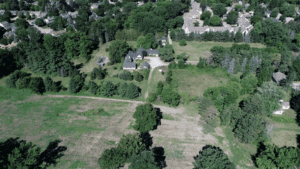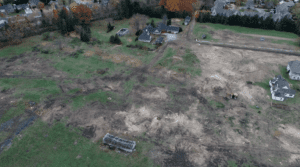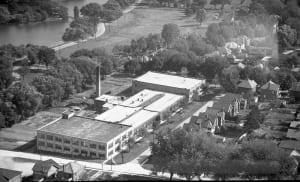Niagara-on-the-Lake news update: “Marotta abandons Rand heritage court challenge”: March 17, 2021 report from Save Our Randwood Estate (SORE)
For the past decade I’ve been writing and thinking about land use issues and (starting more recently) about space use issues.
I became interested in land use as a topic – as a subject of analysis – when I learned in 2010 that a school, the former Parkview School in South Etobicoke, was about to be sold. I’ve become interested, in turn, in space use as a result of what I’ve learned in interviews and reading, in connection with a current book project.

Rear of the Rand Estate at 588 Charlotte, Niagara-on-the-Lake, Nov. 1, 2018. Source: Nov. 12, 2018 SORE article.
The successful effort to save what was formerly called Parkview School involved a form of community self-organizing.
By that I mean that local residents got together and found a way – with substantial help from the Ontario provincial government in power at the time – to save the school. You can read the story at this website, in the event the topic interests you.
Randwood Estate
Another land use narrative that I’ve been following over the years is concerned with the Randwood Estate (“Randwood” is often spoken of as “Rand”) in Niagara-on-the-Lake.

Rear of the Rand Estate at 588 Charlotte, Niagara-on-the-Lake, Nov. 12, 2018. Source: Nov. 12, 2018 SORE article.
Click here for previous posts about the Randwood Estate >
A March 17, 2021 SORE (which stands for “Save Our Randwood Estate”) article is entitled: “Marotta abandons Rand heritage court challenge.”
An excerpt reads:
SORE is pleased to report that the Marotta group has abandoned its court challenge of the legality of the Town’s heritage designation bylaws for the Rand Estate.
Our supporters will recall that in January of 2019, Benny Marotta’s new lawyers launched a court challenge to the legality of the Town’s August 2018 Notices of Intent to Designate the four Rand Estate properties under the Heritage Act.
The Marotta group lawyers first contested SORE’s application to be made a party to that court challenge. After that was decided in favour of SORE, the application was finally heard last year by the Superior Court. As previously reported, the Court soundly rejected that challenge on all grounds and awarded costs to both the Town and SORE. The Marotta group then appealed further to the Court of Appeal. That appeal was scheduled to be heard on March 30.
Commentary
Mike James, who lives in Niagara-on-the-Lake, notes the next hurdle is a July 2021 appeal on two additional properties.
SORE is well-organized group, which knows how to work with relevant information, how to bring people together, and how to communicate effectively.
The informal community group in Long Branch in South Etobicoke that worked starting in 2010 with officials at several school boards, and officials at the provincial government, was similarly a well-organized, richly-resourced group of people. By richly-resourced, I mean they had good access to relevant information, and they knew how to work with it. There was a lot of information to work with! The officials the group worked with included elected officials.
In subsequent years, after extensive planning and input from many sources, the Long Branch Neighbourhood Association came into being. A previous organization, the Ratepayers Association of South Long Branch, which was more narrowly focused and did not emerge as a result of as extensive planning and input from many sources, was relatively short-lived. That said, it served as a step along the way to emergence of the LBNA, which has developed an impressive track record as a community organization.
In Mimico, an informal network of residents is in place, which like the Parkview group highlighted above, does not have a name or formal structure. This informal group, whose leadership includes Charlotte Sheasby-Coleman among other Mimico residents, does a great job of bringing people together, is well-organized, and communicates effectively.
Each such group (formal or informal) serves as a tremendous resource for its local community, and underlines what can be achieved when residents and officials bring people together, get input from as many sources as possible, and know how to communicate effectively.

Aerial view of R.M. Ballantyne Ltd. textile plant on Ballantyne Avenue between North Street and Front Street, Stratford. The land in this area slopes from Water Street (which runs parallel to Ballantyne Avenue) to the Avon River, indicating (with reference to the physiographic history of Southern Ontario) that a large river flowed through this area after end of last Ice Age over 10,000 years ago. Photo source: I believe it’s from Stratford-Perth Archives
Community self-organizing
A previous post from nine years ago regarding community self-organizing is entitled:
Networking drives community self-organizing
A more recent post about local history in Stratford, Ontario also includes a discussion, at the conclusion of the post, about the same topic:

Leave a Reply
Want to join the discussion?Feel free to contribute!